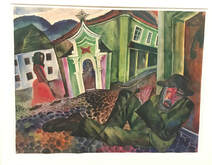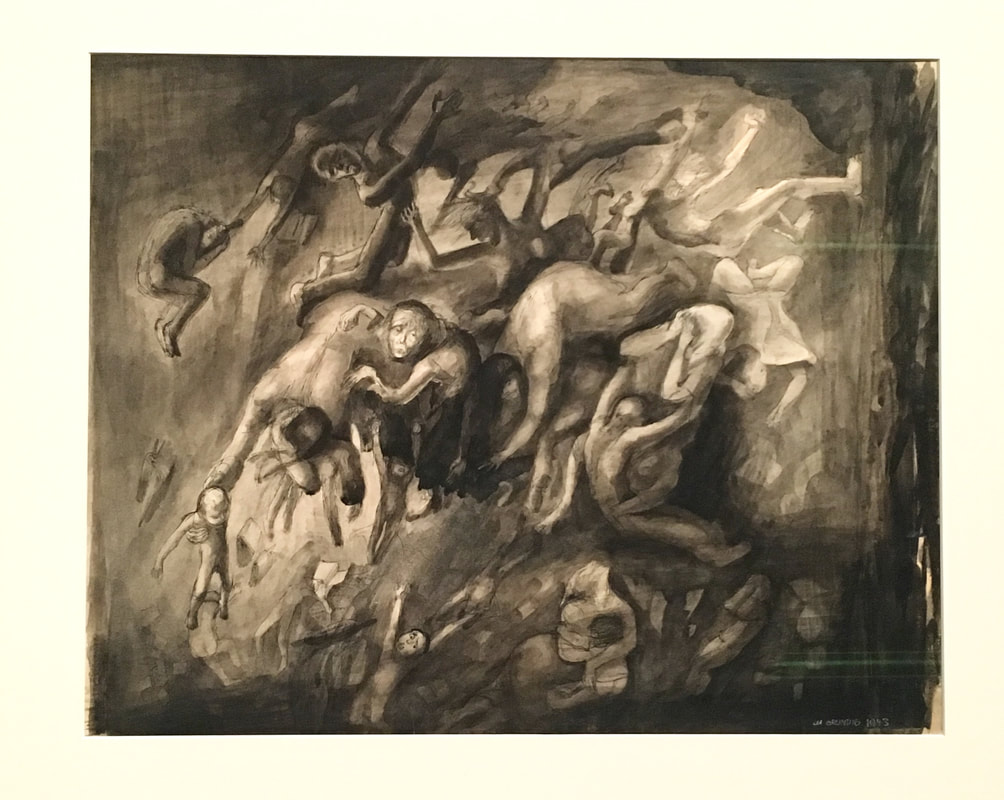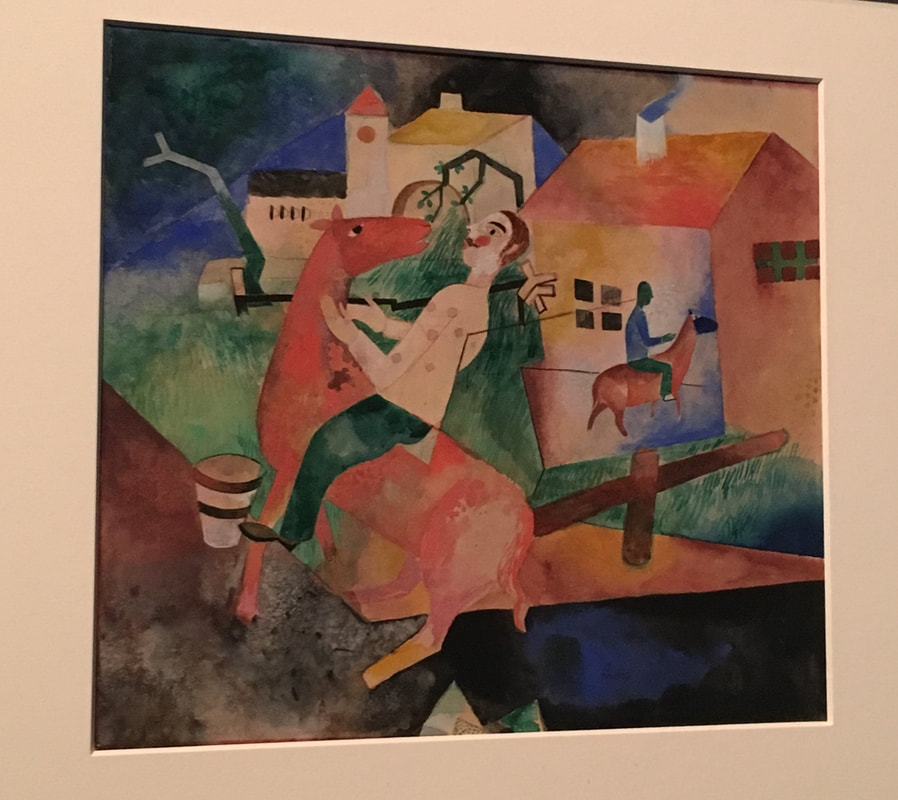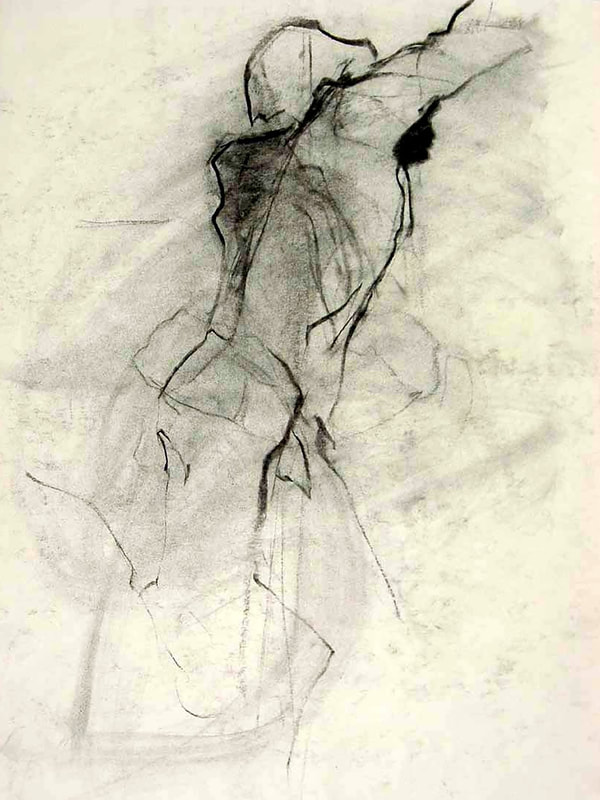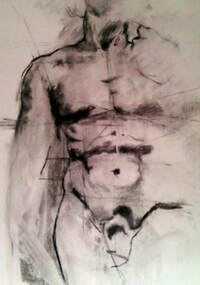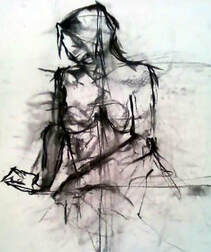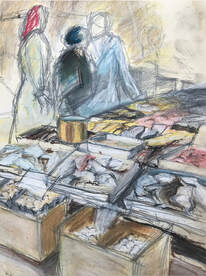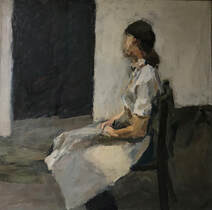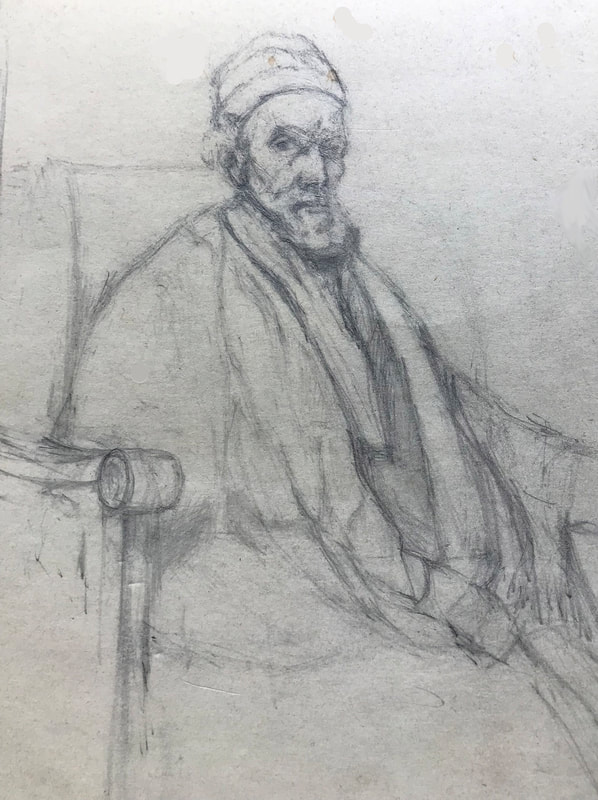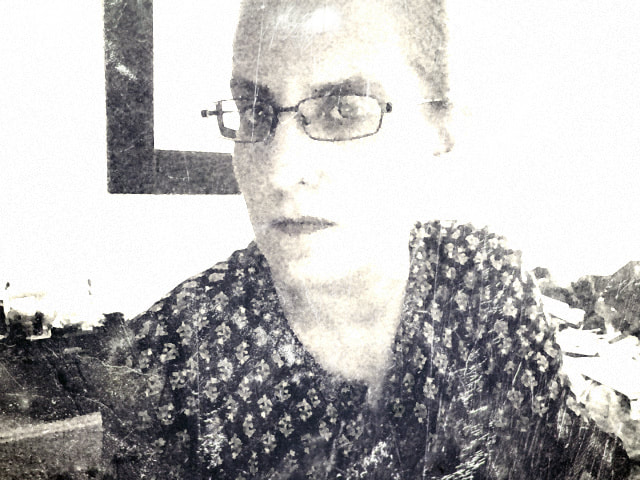|
Very recently I went to see the Magic Realism: Art in Weimar Germany exhibition currently at the Tate Modern. First off, its free to get in so that's a bonus right away for those of us trying to save money in an expensive city!
Secondly, it's so worth a look through as the work is exquisite and the content fascinating especially if you're an artist like myself. I'm fascinated by art history and though I have many favourite areas in art history to which I'm most drawn to, (no pun intended!) but I do find very intriguing, the early part of the twentieth century because it feels to me like it's had the biggest impact on my own art practice. I'm interested in patterns you see, not just in my creative process but in history too and so I find this time period of 1919 to 1933 in Germany most interesting indeed as it does have some echoes into our place in history now for good and bad. Get ready though if you go to this exhibition, some of the work is difficult to look at and there is a room in which a sign has been put up to warn people that there are some disturbing images. I didn't stay long in that room and I didn't take pictures in there either as some images did make me cringe. I will say that when I was in art school in the early 1990s, and in the honeymoon stage of being a painter, I found myself living at the fine art museums and literally drinking in the moody paintings of Max Beckmann, Otto Dix, George Grosz and Max Ernst. I'd then return to my studio and whip out my own moody renditions but without a clear understanding of the history behind why the painters that inspired me painted the way they did. It was only after years of reading and researching that I began to grasp what those artists went through and what they were doing in their own creative processes. Even going through this exhibition at the Tate was eye opening in many ways mostly because I'm at the stage in my life as an adult where I can relate to those artists and what they wanted to express in the world they lived in. I've always been what I call, an "Art Activist" and many times have used my artwork and creative ideas to express how I feel about a political situation that has an impact on my world. My ongoing peace project, "11 Million Hands for 11 Million Lives" is an activist project because it's about fighting for equality between all humans on this planet. I've made it clear in my peace project on multiple occasions that I do not support the little orange president in America as well as the inequality and tension he and other world leaders have brought to our existence. So I can relate completely to the artists making art in the Weimar Republic due to the aftermath of war, the political shifting climate, the economic crisis and the unstable social environment which isn't much different than our own time. The artwork in this exhibition is potent and speaks volumes even a hundred years later! I found myself lingering over certain pieces and trying to imagine what the artist was feeling at the time of making it. Their reactions in pen, paint and pencil to their rocky environment in the aftermath of a devastating world war still rings true today. The impacts of social changes and economic hardships still resonate to what I hear in our news now. The repeating of a pattern in history is a concerning weight and I do wonder how our next few decades will pan out. There's a quote on a board in the 2nd room in the exhibition by the artist, Max Beckmann that reads, "What I want to show in my work is the idea which hides itself behind so-called reality. I am seeking for the bridge which leads from the visible to the invisible." I find I can relate yet again to this thought process because I'm often in search of a similar concept in my own work except that it's taken me a lifetime to understand how to go about it and I've yet to arrive at my outcome......Maybe in another forty years! The exhibition itself shows how artists "spoke out" and expressed themselves in times of terrible trauma during and following World War 1 and that's as it should be......artists are the beating hearts of society and will bleed through their work not to make pretty pictures to be be "real". It's something that feels very much the same for today's world. Nowadays our visual input online or in the galleries is pretty pictures or "how to" videos on how to speed draw an eye......it's all meant to entice and be "pretty" and those of us artists who do make artwork that isn't pretty are often put to the side of society because we're doing something risky and different. As an artist who feels for humanity I know what I want is "real" because I'm fed up with our inequality, conflict and injustice in our world now and pretty just doesn't work for me. I think we artists should learn from the patterns of the past and the artists who dared to speak out and we should make art that shocks and wakes up nations because equality is vital for our survival as a human race. So yes, go see the exhibition at the Tate Modern because it'll open your eyes and help you see the patterns in history and how those artists during that time put their hearts and souls into showing real reactions from the world around them. ** Artwork above from left to right: "The Beggar of Prachatice" 1924 by Conrad Felixmüller "Into the Abyss" 1943 by Lea Grundig "The Rider II" 1919 by Heinrich Campendonk Some links you may want to check out: To take part in my art activist peace project, send a photo of your own hands (palms up please) to: www.facebook.com/11millionhands The highlighted words above in the text will take you to orange things, museums and helpful explanation pages to give you further reading. *If you enjoy reading my Thursday postings about exhibition reviews then stay tuned for next Thursday when I review the Interim Show for the postgraduate courses at Central Saint Martins. There are the best drawing materials for pencil drawings and then there are the best drawing materials for using charcoal and today I shall be sharing with you the best combination of charcoal drawing materials in my expert opinion. The above images are from my own life drawing portfolio and the effects made by the combination of materials. For me the deliciousness of a well worked drawing in charcoal comes from the wonderful marks of all the previous attempts on that same paper that came before it. To be able to dirty up your paper with your first attempts give the foundation to the perfect drawing surface. So in a sense, those early drawing failures are what you are hoping for so you can wipe them out and create that wonderful textured surface.
To achieve this technique I found my perfect combination of materials quite early on in my career. For me the smooth tooth of the Strathmore 400 series paper with its creamy off white colour was the perfect paper if combined with Soft Vine Charcoal, a Gum Eraser and of course a Chamois. And not the tiny bit of Chamois you buy from over priced art supply shops either, but the big piece of Chamois you buy from car detail shops! The soft vine charcoal doesn't behave on the surface of the paper like compressed charcoal because its light and will dust off fairly easily without leaving heavy difficult marks. This is important, in my opinion, to help create that delicious surface. Adding compressed charcoals later down the line of a well worked drawing is perfectly fine but early on its best to stick to the soft vine charcoal. I texture the surface of my paper with quick gestural sketches and wipe out each time the model moves so for life drawing, it helps to warm you up with quick one minute or less poses. Many other artists have said to me to just cover the whole paper in charcoal and then wipe it out for that perfect surface but I think it's more helpful to use first mark making sessions to actually exercise the drawing skill while also loosening up before a long pose. In my experience, creating the texture before a longer pose, gets the artist inspired for digging deeper into a longer pose. The blacker the chamois becomes the better too as this can help drawings further down the line with more interesting textures and marks to be made with differing shades of grey and black. And it's good therapy to dislodge some of the charcoal dust from your chamois by hitting it on a chair leg or something somewhere where you don't mind the dust flying. Just remember not to breathe in the direction of the dust! If you try this and do inhale the dust, then please don't come back to tell me off as we all are responsible for our own actions in this world. I had a friend who thought it best to vacuum up the extra dust on a chamois and ended up sucking the chamois up which then clogged her vacuum and had to be cut out. Very tragic end for that chamois! Using specifically the Gum Eraser with this combination of materials is best if used to bring in light into your drawing rather than as an eraser because its the chamois that erases and textures your work. I love getting the drawing to the point where you have built up the perfect layers of texture but can still see the creaminess of the paper showing through and then can work into the drawing with darker marks and pulling in highlights using the eraser. It gives a sculptural feel to your work that is unlike anything else! On the side of this blog post, you'll see where I've put a little brown box linking you to the exact materials I use which you can buy as I do, from Amazon. Do check it out if you're in the midst of trying out new materials or building a kit of your own. I have included two sizes of the Strathmore 400 series because I use both sizes, obviously preferring the larger size because it gives you more freedom to move. If you have enjoyed this materials post and technique description and are inspired to join in then please consider two ideas: 1. I teach in London using this technique so please get in touch if you'd like lessons. 2. If you are not in London but would still like lessons, then consider contacting me for online (FaceTime/WhatsApp or Skype) lessons. My teaching rates are £40 per hour & must be paid at the time of booking. *Mention this blog post and I'll offer your first & third lessons at 40% off. For all teaching inquiries please email me at: toothpickmoon@gmail.com *Stay tuned for more materials reviews every Monday 9am UK time. This week I'm introducing you to my mother, Juliette McCullough, who happens to have a long history as an artist and is an enormous influence on who I am as an artist too. I've grown up with her artwork and relate to a great many of her works which are as familiar to me as a loved family member so it is for me very interesting to interview my own mother because her own artistic practice helps ground my practice in more than just imagery but also in music, words, people and places. It is her teaching practices, techniques and shared knowledge that I find my own footing as an artist in this world.
Here is part 1 of a 2 part interview with Juliette McCullough. Enjoy & stay tuned next Friday for part 2: Franceska: When did you know for sure that this was your life’s journey? Juliette: From my earliest memories I was driven by this passion to dance and draw, and it was when I was rejected by the Royal Academy of Dance at the grand old age of 10 years old, (the only way into a dancing career at that time), that I had the first inkling that the visual arts was going to be my life. The real decision came at the age of 19 when I found out that the experience of making marks was more important to me than my success or failure at it. This was a real coming to terms with the limitations of what seemed to be my artistic potential at that time, and, the realization that the process of visual discovery and expression was more important to me than anyone else’s opinion of what I produced. I think I came into this power only when I was at my most unsuccessful in producing or showing my images Franceska: Where did you study, who were your teachers? Juliette: I studied at Camberwell School of Arts and Crafts, the Byam Shaw School of Drawing & Painting, and the Royal Academy of Arts in London, England as well as one year at der Akademie der bildenden künste in Munich, Germany. The teachers I really appreciated at Camberwell were Joe Dixon and Theo Mendez who both taught fabric printing. My earliest experience of design and drawing came through those teachers and they were great. Also at Camberwell, Anthony Eyton, Raphael Maklouf, Henry Inlander, Euan Uglow, Anthony Fry and for art history the inspiring, Michael Podro. They were all important in my development. However, I consider the Byam Shaw School to have been the place where I leaned the most. It was then run by Maurice de Sausmarez and his brilliant team of teachers; they were the ones who really taught me to ‘see’. At the Royal Academy my most influential tutors were Roderic Barrett and Peter Greenham. I was so fortunate in that my whole adult education was free. I had to win scholarships which I had to work very hard for; I was the recipient of two Major County Awards and other smaller scholarships, so I benefited from opportunities that no students have today. All the teachers I’ve listed here were committed to offering the best in art education that was possible at that time. They were paramount in preparing me for the life I have today. I also could have studied with Frank Auerbach but I was so conscious of my own undeveloped artistic self and his already considerable fame that I somehow thought I would be overwhelmed by the experience; a decision that I sometimes now regret. However, the culture in the first two years of Camberwell today would give the #MeToo movement a heyday. My respected professors did not fall into that group fortunately. Franceska: What was it like being a young woman studying art in London in the 60’s and 70’s? Juliette: Some of my male contemporaries were happy to tell us that women could never succeed in art because art history proved to us that there were no women artists (it is only recently that women have begun to be included). The whole idea that a woman could succeed in the arts was thought impossible. One of my teachers told me, “Why don’t you go home and bake cakes.” It was such experiences that fired my determination to succeed against all odds. For the first two years we enjoyed one day a week working in the London galleries and museums. Art history lectures were often given in front of the actual images, and teachers would sometimes just remove the class to the British Museum for example. In those days the museums were often almost empty….there were far fewer tourists, and we felt that the art world was there just for us! The vestiges of the second world war were still in evidence around the city, and I remember drawing on a bomb site. Architectural studies were often conducted sitting on cold London pavements looking up at ancient facades. We got to know and draw all the oldest churches. At that time they all seemed to be very quiet uninhabited places steeped in history, with Southwark Cathedral being one of my favourites. Franceska: Compared to today’s young artists, what opportunities were there for you to get into the public eye? Juliette: Luckily I don’t think we had to seek celebrity in the same way that young artists do today. For right or wrong it was accepted that life was going to be hard and that success in one’s craft was not the same as commercial success. There was a belief that early commercial success was detrimental to the development of the young artist. Opportunities to exhibit came through our schools, but being in the heart of London, even those exhibitions were open to large informed audiences. Of course there was no internet, or Facebook, Twitter or Instagram. Reputation was built through word of mouth. Franceska: What successes as a young artist did you have? Juliette: The first time my paintings gained any recognition was from a small prize at the Byam Shaw School. The Royal Academy of Arts gave us many opportunities to compete for exhibition opportunities in the main galleries during that time. Initially I had a lot of rejections until my last year when I won a silver medal for life painting and sold a painting to the artist, Francis Bacon. Franceska: What was that experience like, selling to a famous artist like Francis Bacon? Juliette: One of my tutors told me that Francis Bacon had been in the galleries and liked my painting. The following day, he came down to the studios to meet me, unbelievably I was away teaching on that morning “so I missed my chance with one of the Lords of this life”. When I returned, my friends who were in the studio with him, told me about the encounter and relayed to me that he had said, “This girl is a painter”. Apparently Bacon asked what I was like, to which one of my tutors replied, “she is a feminine little thing”. This seemed to me at the time yet another little reminder of how we as women were not taken as seriously as we would have liked to have been. This was the 1970’s and I was making figurative paintings at a time when it was very unfashionable. I felt as if I was swimming in the dark and didn’t know which way was up, so Francis Bacon’s words gave me hope that I might somehow be on the right track after all. It helped me come to the awareness that the only road for me was to follow my own intuition regardless of the fashions of the day. Apart from this I knew that this experience would not bring me any further opportunity, and indeed it has not. The act of making meaningful images remains the most difficult process I know, regardless of what might be considered successes, it is still always an intense struggle to pull the images out from my boots! Franceska: Thank you for answering this first series of questions and I look forward to part 2 next Friday in which we will delve further into your life as an artist and learn about your current artistic practice. Juliette's artist website: www.juliettemccullough.com Juliette's instagram: @Juliette_McCullough Juliette's Facebook Page: @PainterOnTheEdgeOfMystery *To read more artist interviews and to follow up with part 2 of this interview please return here every Friday 9am UK time. |
AuthorMy name is Franceska McCullough and I'm the owner and artist of Toothpickmoon. Here I will share my studio practice in all it's forms. *Disclosure: The links I'm using on this blog will only ever relate to the products I myself use in my own practice.
Categories
All
Archives
April 2020
|
